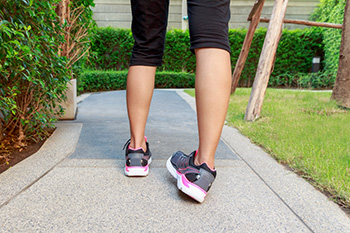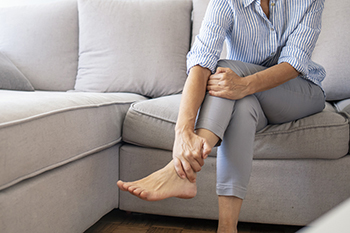

A bunion is identified as a bony protrusion that gradually forms on the side of the big toe. It affects women more than men, and this may be a result of the type of shoes that are frequently worn. High heels fall into this category, because they have little room for the toes to move freely in. Limiting the time wearing high heels is suggested. If medical attention is not sought, the growing bunion can cause the other toes to shift toward each other, and larger shoes may need to be purchased. Research has shown that men are also affected by bunions, most commonly due to genetic reasons. Foot structure and bunions tend to run in families, and it is beneficial for men to be aware of the type of shoes they choose to wear. Effective prevention methods include buying shoes that can adequately accommodate the width of the toes. If you have a bunion, it is suggested that you consult with a podiatrist who can determine what the right course of treatment is for you.
If you are suffering from bunion pain, contact Dr. Stephan J. LaPointe of Georgia Foot & Ankle Specialists . Our doctor can provide the care you need to keep you pain-free and on your feet.
What Is a Bunion?
Bunions are painful bony bumps that usually develop on the inside of the foot at the joint of the big toe. As the deformity increases over time, it may become painful to walk and wear shoes. Women are more likely to exacerbate existing bunions since they often wear tight, narrow shoes that shift their toes together. Bunion pain can be relieved by wearing wider shoes with enough room for the toes.
Causes
Symptoms
In order to diagnose your bunion, your podiatrist may ask about your medical history, symptoms, and general health. Your doctor might also order an x-ray to take a closer look at your feet. Nonsurgical treatment options include orthotics, padding, icing, changes in footwear, and medication. If nonsurgical treatments don’t alleviate your bunion pain, surgery may be necessary.
If you have any questions, please feel free to contact our office located in Rome, GA . We offer the newest diagnostic and treatment technologies for all your foot care needs.

Ankle pain is a common occurrence, which shouldn’t be surprising because the ankle is involved in every step you take. Ankle injuries are usually caused by tripping on a step or curb or twisting the ankle during a sports activity. This can result in a ligament sprain. With an ankle sprain, the foot rolls inward and the ankle outward, thereby stretching a ligament beyond its normal range. Symptoms include pain, swelling, redness, and warm when touched. Some stiffness may follow. Ankle sprains often interfere with bearing weight on the affected foot. If you are in extreme pain from an ankle injury and cannot put weight on that foot, please seek medical help immediately. The first thing to do is stay off the affected ankle, keep it elevated, and put ice on it to help reduce the swelling. Seeing a podiatrist as soon as possible is suggested to determine the severity and extent of the injury. Healing from an ankle injury can take weeks or even months. Braces or other walking devices may be prescribed to allow the ankle to move while keeping it stable. Allowing the ankle to fully heal is imperative for avoiding re-injury or chronic ankle problems in the future. For more information, please contact a podiatrist.
Ankle sprains are common but need immediate attention. If you need your feet checked, contact Dr. Stephan J. LaPointe from Georgia Foot & Ankle Specialists . Our doctor can provide the care you need to keep you pain-free and on your feet.
How Does an Ankle Sprain Occur?
Ankle sprains take place when the ligaments in your ankle are torn or stretched beyond their limits. There are multiple ways that the ankle can become injured, including twisting or rolling over onto your ankle, putting undue stress on it, or causing trauma to the ankle itself.
What Are the Symptoms?
Preventing a Sprain
Treatment of a Sprain
Treatment of a sprain depends on the severity. Many times, people are told to rest and remain off their feet completely, while others are given an air cast. If the sprain is very severe, surgery may be required.
If you have suffered an ankle sprain previously, you may want to consider additional support such as a brace and regular exercises to strengthen the ankle.
If you have any questions please feel free to contact our office located in Rome, GA . We offer the newest diagnostic and treatment technologies for all your foot and ankle needs.

Plantar fasciitis is a widespread and important kind of foot affliction to be aware of. It is primarily developed when an individual’s plantar fascia, or band of tissue that runs along the arch of the foot, becomes inflamed and aggravated. Pain can be felt in the feet as a result. Importantly, this condition is distinctly different from sciatica, although they each cause some kind of foot pain. Sciatica, by contrast, can occur in an individual when certain nerves that are located in the back can become compressed. Due to the compression, sensations of pain and numbness can travel down the body into the feet. For more information about what makes plantar fasciitis different from sciatica, please contact a podiatrist today.
Plantar fasciitis is a common foot condition that is often caused by a strain injury. If you are experiencing heel pain or symptoms of plantar fasciitis, contact Dr. Stephan J. LaPointe from Georgia Foot & Ankle Specialists . Our doctor can provide the care you need to keep you pain-free and on your feet.
What Is Plantar Fasciitis?
Plantar fasciitis is one of the most common causes of heel pain. The plantar fascia is a ligament that connects your heel to the front of your foot. When this ligament becomes inflamed, plantar fasciitis is the result. If you have plantar fasciitis you will have a stabbing pain that usually occurs with your first steps in the morning. As the day progresses and you walk around more, this pain will start to disappear, but it will return after long periods of standing or sitting.
What Causes Plantar Fasciitis?
There are some risk factors that may make you more likely to develop plantar fasciitis compared to others. The condition most commonly affects adults between the ages of 40 and 60. It also tends to affect people who are obese because the extra pounds result in extra stress being placed on the plantar fascia.
Prevention
There are a variety of treatment options available for plantar fasciitis along with the pain that accompanies it. Additionally, physical therapy is a very important component in the treatment process. It is important that you meet with your podiatrist to determine which treatment option is best for you.
If you have any questions, please feel free to contact our office located in Rome, GA . We offer the newest diagnostic and treatment technologies for all your foot care needs.

Arthritis is a medical condition that affects a wide variety of individuals across the country. Arthritis primarily impacts the joints of the body, causing them to become inflamed. Individuals who suffer from arthritis can also experience arthritis in their feet. One particular kind of arthritis in the feet is known as midfoot arthritis. This condition occurs at the top, and middle part of the foot when the cartilage between bones diminishes. As a result, the bones can rub up against each other which can ultimately cause inflammation. Certain risk factors are generally associated with midfoot arthritis. For example, suffering from some kind of other foot injury or trauma might make you more susceptible to developing midfoot arthritis. Additionally, one’s natural foot shape might also make one predisposed to developing midfoot arthritis. Schedule an appointment with a podiatrist today for more information.
Arthritis can be a difficult condition to live with. If you are seeking treatment, contact Dr. Stephan J. LaPointe from Georgia Foot & Ankle Specialists . Our doctor can provide the care you need to keep you pain-free and on your feet.
Arthritic Foot Care
Arthritis is a joint disorder that involves the inflammation of different joints in your body, such as those in your feet. Arthritis is often caused by a degenerative joint disease and causes mild to severe pain in all affected areas. In addition to this, swelling and stiffness in the affected joints can also be a common symptom of arthritis.
In many cases, wearing ill-fitting shoes can worsen the effects and pain of arthritis. Wearing shoes that have a lower heel and extra room can help your feet feel more comfortable. In cases of rheumatoid arthritis, the arch in your foot may become problematic. Buying shoes with proper arch support that contour to your feet can help immensely.
Alleviating Arthritic Pain
It is best to see your doctor for the treatment that is right for your needs and symptoms. Conditions vary, and a podiatrist can help you determine the right method of care for your feet.
If you have any questions, please feel free to contact our office located in Rome, GA . We offer the newest diagnostic tools and technology to treat your foot and ankle needs.